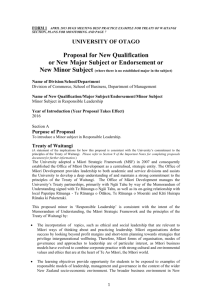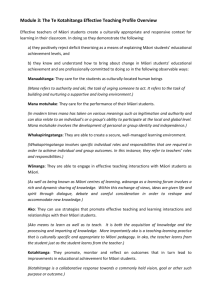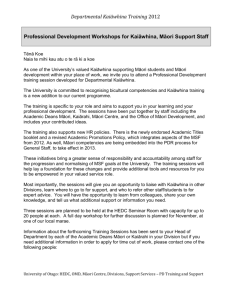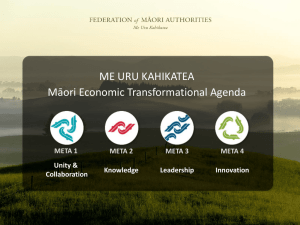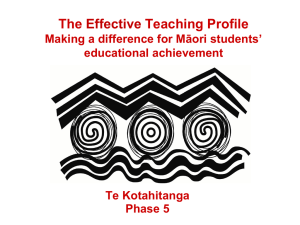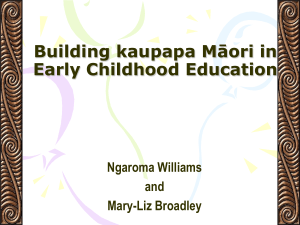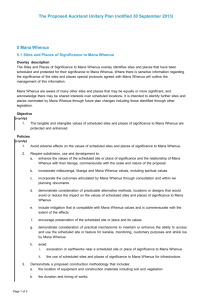The Proposed Auckland Unitary Plan
advertisement
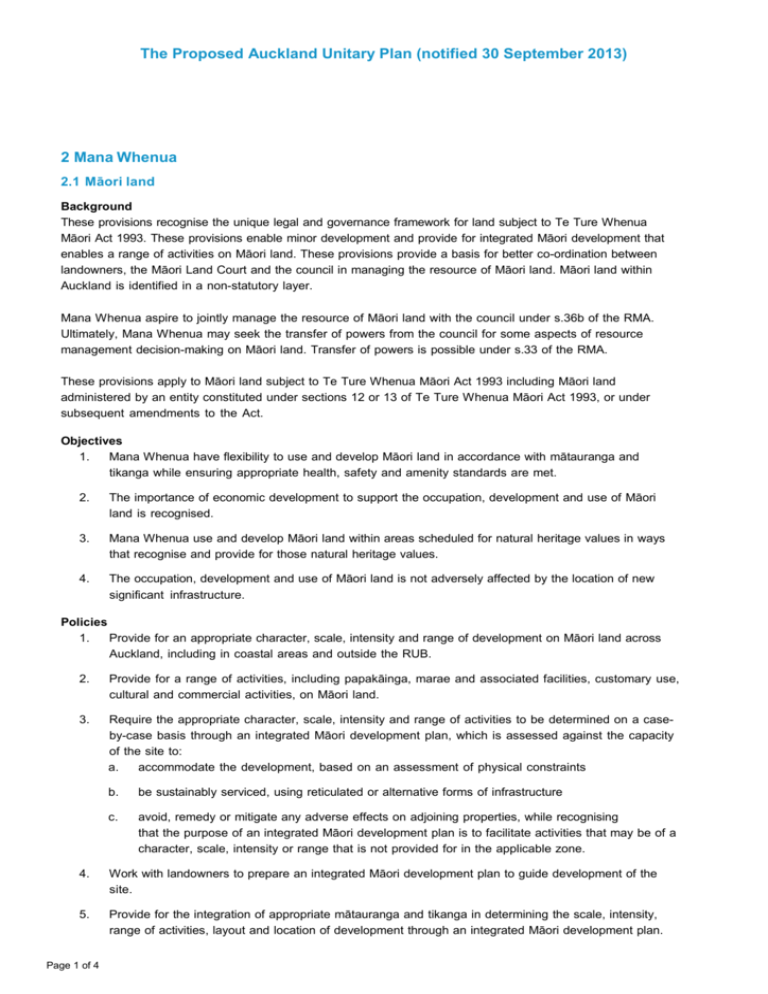
The Proposed Auckland Unitary Plan (notified 30 September 2013) 2 Mana Whenua 2.1 Māori land Background These provisions recognise the unique legal and governance framework for land subject to Te Ture Whenua Māori Act 1993. These provisions enable minor development and provide for integrated Māori development that enables a range of activities on Māori land. These provisions provide a basis for better co-ordination between landowners, the Māori Land Court and the council in managing the resource of Māori land. Māori land within Auckland is identified in a non-statutory layer. Mana Whenua aspire to jointly manage the resource of Māori land with the council under s.36b of the RMA. Ultimately, Mana Whenua may seek the transfer of powers from the council for some aspects of resource management decision-making on Māori land. Transfer of powers is possible under s.33 of the RMA. These provisions apply to Māori land subject to Te Ture Whenua Māori Act 1993 including Māori land administered by an entity constituted under sections 12 or 13 of Te Ture Whenua Māori Act 1993, or under subsequent amendments to the Act. Objectives 1. Mana Whenua have flexibility to use and develop Māori land in accordance with mātauranga and tikanga while ensuring appropriate health, safety and amenity standards are met. 2. The importance of economic development to support the occupation, development and use of Māori land is recognised. 3. Mana Whenua use and develop Māori land within areas scheduled for natural heritage values in ways that recognise and provide for those natural heritage values. 4. The occupation, development and use of Māori land is not adversely affected by the location of new significant infrastructure. Policies 1. Provide for an appropriate character, scale, intensity and range of development on Māori land across Auckland, including in coastal areas and outside the RUB. 2. Provide for a range of activities, including papakāinga, marae and associated facilities, customary use, cultural and commercial activities, on Māori land. 3. Require the appropriate character, scale, intensity and range of activities to be determined on a caseby-case basis through an integrated Māori development plan, which is assessed against the capacity of the site to: a. accommodate the development, based on an assessment of physical constraints b. be sustainably serviced, using reticulated or alternative forms of infrastructure c. avoid, remedy or mitigate any adverse effects on adjoining properties, while recognising that the purpose of an integrated Māori development plan is to facilitate activities that may be of a character, scale, intensity or range that is not provided for in the applicable zone. 4. Work with landowners to prepare an integrated Māori development plan to guide development of the site. 5. Provide for the integration of appropriate mātauranga and tikanga in determining the scale, intensity, range of activities, layout and location of development through an integrated Māori development plan. Page 1 of 4 The Proposed Auckland Unitary Plan (notified 30 September 2013) 6. Consider alternative approaches to site access and infrastructure provision in rural or coastal areas where the development of Māori land is constrained by access or the availability of infrastructure. 7. Where an application is received for development on Māori land within areas scheduled for natural heritage values, the council will work with landowners to facilitate appropriate development by: a. requiring an integrated Māori development plan to balance the need to enable development, occupation and use of Māori land with the recognition of values scheduled in all overlays, in accordance with mātauranga and tikanga 8. Page 2 of 4 b. providing an opportunity for the extent of the scheduled area to be re-assessed in consultation with the landowners c. considering measures for the on-going protection and maintenance of values on the site scheduled in overlays through the use of protective covenants, fencing or other management techniques d. investigating alternative locations within the site, or identifying other locations to which development rights could be transferred e. considering alternative approaches to development that maintain or enhance the values scheduled in overlays f. recognising that there may be no or limited alternative locations for whanau, hapū or iwi to occupy their ancestral land. Encourage utility operators to consider alternative routes and locations for infrastructure outside Māori land, where new infrastructure development may adversely affect the occupation, development and use of Māori land. The Proposed Auckland Unitary Plan (notified 30 September 2013) 2.2 Treaty settlement land Background These provisions recognise that the principles of Te Tiriti (including the principle of redress and the principle of active protection) require the council to enable the use and development of land acquired by Mana Whenua through Treaty settlement legislation. These provisions enable minor development and provide for an integrated Māori development plan to enable a range of activities on Treaty settlement land. These provisions recognise the importance of the relationship of Mana Whenua with land acquired through the Treaty settlement process, and the desire of Mana Whenua to reestablish ahi kā on lands within their ancestral rohe. The provisions provide a basis for collaboration between landowners and the council in managing the resource of Treaty settlement land. Treaty settlement land within Auckland is identified in a non-statutory layer. This layer is updated to reflect new Deeds of Settlement and Treaty Settlement legislation. Mana Whenua aspire to jointly manage the resource of Treaty settlement land with the council under s.36b of the RMA. Ultimately, Mana Whenua may seek the transfer of powers from the council for some aspects of resource management decision-making on Treaty settlement land. Transfer of powers is possible under s.33 of the RMA. These provisions apply to land acquired by Mana Whenua through Claims Settlement Acts. These provisions do not apply to land acquired by Mana Whenua through the right of first refusal process. Objectives 1. Mana Whenua have flexibility to use and develop Treaty settlement land in accordance with mātauranga and tikanga while ensuring appropriate health, safety and amenity standards are met. 2. Mana Whenua use land acquired as commercial redress to support their social and economic development. 3. Mana Whenua can access and use land acquired as cultural redress to support cultural activities. 4. Mana Whenua use and develop Treaty Settlement land within areas scheduled for natural heritage values in ways that recognise and provide for those natural heritage values. 5. The occupation, development and use of Treaty Settlement land is not adversely affected by the location of new significant infrastructure. Policies 1. Provide for development of an appropriate character, scale, intensity on Treaty settlement land across Auckland, including in coastal areas and outside the RUB. 2. Provide for a range of activities, including papakāinga, marae and associated facilities, customary use, cultural and commercial, on Treaty settlement land. 3. Require the character, scale, intensity and range of activities and development to be determined on a case-by-case basis having regard to the capacity of the site to: a. accommodate the development, based on an assessment of physical constraints 4. Page 3 of 4 b. be sustainably serviced, using reticulated or alternative forms of infrastructure c. avoid, remedy or mitigate any adverse effects on adjoining sites, while recognising the purpose of an integrated Māori development plan is to facilitate activities that may be of a character, scale, intensity or range that is not provided for in the applicable zone. Work with landowners to prepare an integrated Māori development plan to guide development of the site. The Proposed Auckland Unitary Plan (notified 30 September 2013) 5. Provide for the integration of mātauranga and tikanga in determining the scale, intensity, range of activities and the layout and location of development through an integrated Māori development plan. 6. Consider alternative approaches to infrastructure provision in rural or coastal areas where the development of Treaty settlement land is constrained by the availability of infrastructure. 7. Where an application is received for development on Treaty settlement land within areas scheduled for natural heritage values, the council will work with landowners to facilitate appropriate development by: a. requiring an integrated Māori development plan to balance the need to enable development, occupation and use of Treaty Settlement land with the recognition of values scheduled in all overlays, in accordance with mātauranga and tikanga b. providing an opportunity for the extent of the scheduled area to be re-assessed in consultation with the landowners c. considering measures for the ongoing protection and maintenance of values on the site scheduled in overlays through the use of protective covenants, fencing or other management techniques d. investigating alternative locations within the site, or identifying other locations to which development rights could be transferred e. considering alternative approaches to development that maintain or enhance the values scheduled in overlays f. recognising that there may be no or limited alternative locations for whānau, hapū or iwi to occupy their ancestral land. 8. Where Mana Whenua propose an activity on Treaty Settlement land, consideration should be given to the benefits for the wider community and environment provided by any property specific protection mechanism. 9. Encourage utility operators to consider alternative routes and locations for infrastructure outside the Treaty Settlement land, where new infrastructure development may adversely affect the occupation, development and use of Treaty Settlement land. Page 4 of 4

